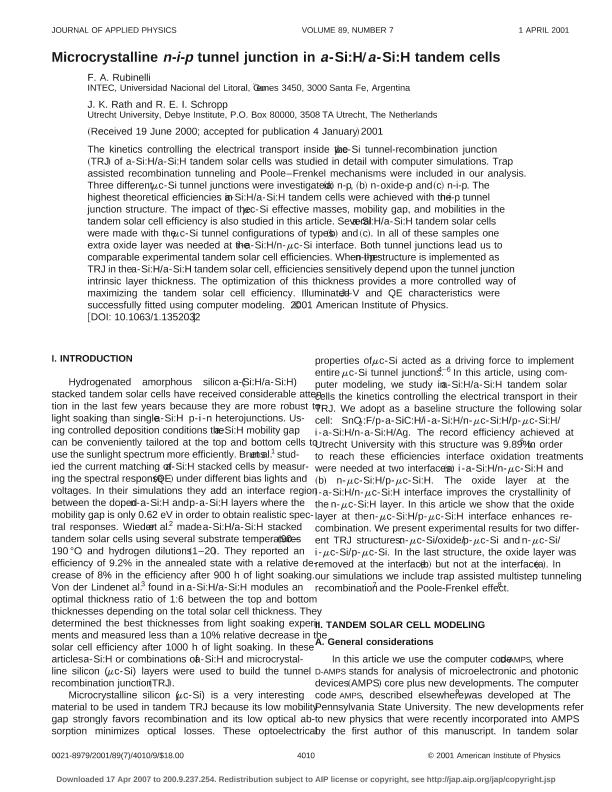Mostrar el registro sencillo del ítem
dc.contributor.author
Rubinelli, Francisco Alberto

dc.contributor.author
Rath, J.K.
dc.contributor.author
Schropp, R.E.I.
dc.date.available
2017-11-08T12:11:34Z
dc.date.issued
2001-04
dc.identifier.citation
Rubinelli, Francisco Alberto; Rath, J.K.; Schropp, R.E.I.; n-i-p Microcrystalline Tunnel Junction in a-Si:H/a-Si:H Tandem Cells; American Institute of Physics; Journal of Applied Physics; 89; 7; 4-2001; 4010-4020
dc.identifier.issn
0021-8979
dc.identifier.uri
http://hdl.handle.net/11336/27787
dc.description.abstract
The kinetics controlling the electrical transport inside the μc-Si tunnel-recombination junction (TRJ) of a-Si:H/a-Si:H tandem solar cells was studied in detail with computer simulations. Trap assisted recombination tunneling and Poole–Frenkel mechanisms were included in our analysis. Three different μc-Si tunnel junctions were investigated: (a) n-p, (b) n-oxide-p and (c) n-i-p. The highest theoretical efficiencies in a-Si:H/a-Si:H tandem cells were achieved with the n-i-p tunnel junction structure. The impact of the μc-Si effective masses, mobility gap, and mobilities in the tandem solar cell efficiency is also studied in this article. Several a-Si:H/a-Si:H tandem solar cells were made with the μc-Si tunnel configurations of types (b) and (c). In all of these samples one extra oxide layer was needed at the i-a-Si:H/n-μc-Si interface. Both tunnel junctions lead us to comparable experimental tandem solar cell efficiencies. When the n-i-p structure is implemented as TRJ in the a-Si:H/a-Si:H tandem solar cell, efficiencies sensitively depend upon the tunnel junction intrinsic layer thickness. The optimization of this thickness provides a more controlled way of maximizing the tandem solar cell efficiency. Illuminated J–V and QE characteristics were successfully fitted using computer modeling.
dc.format
application/pdf
dc.language.iso
eng
dc.publisher
American Institute of Physics

dc.rights
info:eu-repo/semantics/openAccess
dc.rights.uri
https://creativecommons.org/licenses/by-nc-sa/2.5/ar/
dc.subject
Tandem Solar Cells
dc.subject
Recombination Junctions
dc.subject
Amorphous Silicon
dc.subject
Modelling
dc.subject.classification
Ingeniería de Sistemas y Comunicaciones

dc.subject.classification
Ingeniería Eléctrica, Ingeniería Electrónica e Ingeniería de la Información

dc.subject.classification
INGENIERÍAS Y TECNOLOGÍAS

dc.title
n-i-p Microcrystalline Tunnel Junction in a-Si:H/a-Si:H Tandem Cells
dc.type
info:eu-repo/semantics/article
dc.type
info:ar-repo/semantics/artículo
dc.type
info:eu-repo/semantics/publishedVersion
dc.date.updated
2017-11-03T20:26:59Z
dc.journal.volume
89
dc.journal.number
7
dc.journal.pagination
4010-4020
dc.journal.pais
Estados Unidos

dc.journal.ciudad
Newsville
dc.description.fil
Fil: Rubinelli, Francisco Alberto. Consejo Nacional de Investigaciones Científicas y Técnicas. Centro Científico Tecnológico Conicet - Santa Fe. Instituto de Desarrollo Tecnológico para la Industria Química. Universidad Nacional del Litoral. Instituto de Desarrollo Tecnológico para la Industria Química; Argentina
dc.description.fil
Fil: Rath, J.K.. Utrecht University; Países Bajos
dc.description.fil
Fil: Schropp, R.E.I.. Utrecht University; Países Bajos
dc.journal.title
Journal of Applied Physics

dc.relation.alternativeid
info:eu-repo/semantics/altIdentifier/doi/http://dx.doi.org/10.1063/1.1352032
Archivos asociados
